Loco-hauled JR East Trains
In a country where much travel is by train, it’s not too surprising that some resorts and regions catering to the tourist trade provide dedicated trains to bring people to them from the city. With the expansion of the Shinkansen network, many of these operate only over branch lines, picking passengers up from the nearest Shinkansen station. However in peak season, some trains are likely to operate from urban centers such as Tōkyō.
Note: Resort Trains operated by JR East, other than locomotive-hauled sleepers, appear to be classified as Joyful Trains, so this page is mainly about JR East sleeper trains operating around Tōkyō. See the Resort Trains page for non-JR trains, and the Joyful Trains page for those JR trains more commonly considered Joyful Trains.
A trio of locomotive-hauled overnight sleeper trains runs between Tōkyō and the northern island of Hokkaido. Their appeal to tourists is one of the reasons these remain in service, when most other “Blue Trains”, as these are called, have been cancelled in recent years.
Named trains have special markers that combine the name of the train with a graphic, usually related to the name in some way. These markers are placed on the locomotive (called a headmark) or displayed on the first car (if an EMU or DMU). They may also be displayed on the rear of the last car, and painted on the sides of cars.
JR Blue Trains
Blue trains are locomotive-hauled intercity passenger trains, so named for the blue color most of them wore in the latter part of the twentieth century.
Three of the Blue Trains continue to operate out of Tōkyō’s Ueno Station, although only two of them are blue. These were formerly hauled by EF81 locomotives near the city (see the preceding Passenger Locomotives page for details on the EF81), but the recently introduced EF510-500 series is taking over that role.
Akebono (あけぼの) JR East Blue Train
The Akebono is or was the Ueno (in Tōkyō) to Aomori (in Hokkaido) overnight sleeper train. Originally hauled by an EF65-1000, and later by an EF81 (or perhaps both on different sections of the line). It does not appear that the EF510-500 is planned for use with this train. According to wikipedia the standard consist is thirteen of the 24-series cars, including a power car, one “single delux” sleeper, two “solo” sleepers, seven “open-bed” sleepers, and two “normal car seat” cars, one designated “women only”. The three solo and single delux cars allow smoking, the rest are non-smoking.
There were fears that service would be terminated in late 2010 due to preparations for extending the Shinkansen line through the tunnel to Hokkaido, but these proved unfounded. Operation may have ended (or been temporarily suspended) in 2011 due to the earthquake, although the Japanese Wikipedia page mentions an Ueno - Hirosaki (in Aomori) service that ran from December 2012 to January 2013 using a 583, the first time this class of EMU has been used on the service since the 1980’s (this may, however, have been in reference to a Hokuriku line train service rather than the Akebono).
Hobby Search (a toy store) says than an EF64 was used from Ueno to Nagaoka, and an EF81 from Nagaoka to Aomori. And this is consistent with a statement on the Japanese Wikipedia page noted above, suggesting that problems with the EF81 caused them to not be used on part of the line.
Kato makes a model of this with a 6-car basic set and a 3-car add-on (Japanese). This may be of an older version of the train.
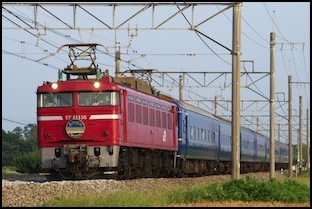
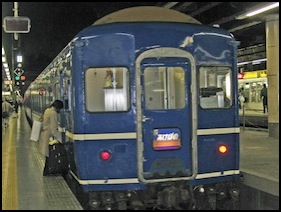
EF81-136 with Akebono headmark (2007), and 24-series car with Akebono marking (2006)
Photographers: Sui-setz, and Shacho0822
Cassiopeia (カシオペア), JR East Blue Train
The Cassiopeia is an Ueno to Sapporo (in Hokkaido) overnight sleeper train. EF510-509 and -510 have been painted in a silver color to match this train, although it has also been hauled by blue models of that locomotive. The train consists of 12 cars, including a lounge/generator car and a dining car, and debuted in 1999. All sleeping berths are private berths. It makes the trip in 17 hours and 10 minutes, one hour longer than the Hokutosei. Prior to June 2010 an EF81 was used on departure from Ueno, with other locomotives used in the north where necessary. As of June the EF81 has been replaced by the EF510-500 series, which are assigned to Tabata Depot in Tōkyō for this use.
As of the March 2010 JR East timetable the Cassiopeia departs Ueno at 16:10, arriving Sapporo the next day at 9:32, and departs Sapporo at 16:12, arriving Ueno at 9:25 the following day. According to the Japanese wikipedia page for Cassiopeia, there is only one set of the E26 cars so the train runs on alternate days (Mon, Wed, Sat from Sapporo, if I’m reading it right).
Kato is making a model of this (due in December 2010), which will be sold as a basic 4-car set which includes a silver EF510-500, a 3-car add-on and a 6-car add-on (as least, that’s what the description on Hobby Search says, but the list of cars suggests it’s a 5-car set, which makes more sense). Tomix also has a model, sold as a basic set with an EF81 and two cars (item 92251), and two add-on sets with four (92252) and six cars (92253).
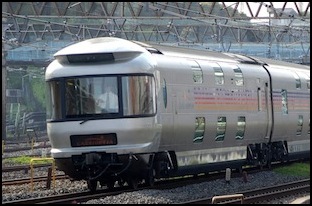
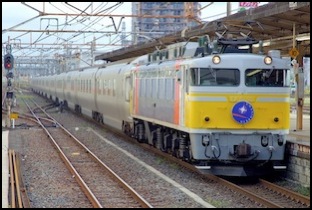
Cassiopeia 26-series observation car (2008), and EF81-92 with headmark at Utsunomiya(2007)
Photographers: Sui-setz, and 出々 吾壱
Hokutosei (北斗星), JR East Blue Train
The Hokutosei (the name translates as “Big Dipper”, although “North Star” may also be a translation) is an Ueno to Sapporo (in Hokkaido) overnight sleeper train. It debuted in 1988, and includes a mix of private and open sleeping berths.
According to the Japanese wikipedia page, since 2008 it operates in a twelve-car train, including the power/baggage car, a dining car, and ten sleeper cars. Cars 1-6 are owned by JR Hokkaido and 7-12 by JR East. Tomix makes separate models of JR East and JR West sets, so apparently at one time these operated as separate trains. There must be at least two sets if this is a daily train, as the route is 1,216 km long, and the trip takes 16 hours and 10 minutes each way.
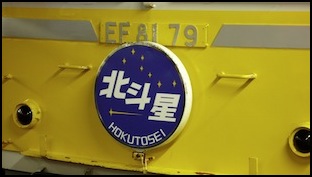
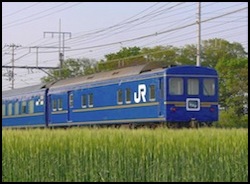
Hokutosei Headmark (2008), and power car with marking (2007)
Photographers: macglee, and まも (Mamo)
As noted above, an EF81 based in Tabata Depot was formerly used to haul the train to Aomori, where a JR Hokkaido ED79 took over to Hakodate (i.e., through the tunnel), and a DD51 diesel to Sapporo. The EF51-500 replaced the EF81 as of 14 July 2010.
As of the March 2010 JR East timetable the Hokutosei departs Ueno at 19:03, arriving Sapporo the next day at 11:15, and departs Sapporo at 17:12, arriving Ueno at 9:38 the next day.
March 15, 2008 car arrangement (per Japanese Wikipedia), from the northern end:
4B private persons simple sleeper “B compartments”
2B sleeper private persons “Duet”
2B sleeper private persons “Duet”
2B sleeper private persons “Duet”
1B-person sleeper cell “Solo”
1B-person sleeper cell “Solo”
Lobby Mini (with shower)
Dining Car
Private two-person bed “Twin Delux”
Bed for 1 private-person “Royal”
1B-person sleeper cell “Solo”
Bed for 1 private-person “Royal”
2B sleeper private persons “Duet”
Open bed B
Power/Baggage Car
Japanese train cars (and also freight cars) are described by a series of phonetic labels, for example an “ORoHaNe” is a “32.5-37.5t, green class/standard class, sleeper”. Kato released a model of a recent version (I think) of the Hokutosei with the following cars (the first six described as belonging to JR Hokkaido, and the second six to JR East, which seems to line up with the 2008 description, and, if I’m reading the Google translation correctly, the text suggests this is the arrangement in use from 2008):
Ohanehu25-2 (32.5-37.5t, standard class, sleeper, HU?)
Ohane25-562 (32.5-37.5t, standard class, sleeper) “Duet”
Ohane25-563 (32.5-37.5t, standard class, sleeper) “Duet”
Ohane25-566 (32.5-37.5t, standard class, sleeper) “Duet”
Ohane25-552 (32.5-37.5t, standard class, sleeper) “Solo”
Suhane25-503 (37.5 - 42.5t, standard class, sleeper) “Lobby, Solo”
Sushi24-505 (37.5 - 42.5t, catering car) “Grand Chariot (dining car)”
Orone25-505 (32.5-37.5t, green class, sleeper) “Twin Delux”
Orohane25-502 (32.5-37.5t, green class/standard class, sleeper) “Royal Solo”
Orohane24-553 (32.5-37.5t, green class/standard class, sleeper) “Royal Delux”
Ohanehu25-215 (32.5-37.5t, standard class, sleeper, HU?)
Kani24-505 (over 47.5t, luggage car)
The “Solo”, “Duet”, Twin Delux” and “Royal” are all described explicitly as having rooms with beds. I think “HU” refers to open sleeping cars where the seats recline into beds, based on the “open bed” description and some other things I’ve read, although the wikipedia entry implies that the first car has “bed compartments” of some kind, while the one at the other end of the train is open beds).
Per another Japanese site, the “Solo” and “Duet” are a “one person private room” and a two-person “cell” (which makes these sound like sleeping berths, rather than rooms. The “Royal” and “Deluxe Twin” are described as rooms (and both are first-class cars, so it makes sense they’d have better accommodations).
A “Lobby Car” (Japanese wikipedia) is basically a lounge car; a car equipped with large, comfortable seats (not the usual bench or airline style seating). The one on the Hokutosei is apparently a mix of Lobby and Solo rooms, and is equipped with a shower cubicle as well.
As noted, Kato made a model of this (Japanese) with two six-car sets to make the full train. The blue EF510-500 is available separately (Japanese). Tomix also released a model of the train, with a basic 5-car set (item 92397) and a 6-car add-on set (item 92398); it's not clear what version is represented but it's one car short to be the current one.
Hokuriku (北陸), JR East Blue Train (discontinued 2010)
The Hokuriku was a Limited Express sleeper operated out of Ueno Station to Kanazawa, in Western Japan on the Sea of Japan coast. It used 14-series coaches (typically eight, per Wikipedia, and the same articles also says it used 20-series coaches after 1975), and at the Tōkyō end was pulled by an EF64-1000 locomotive. The coaches (apparently only one set after 19xx) were based out of Oku Depot, in Tōkyō.
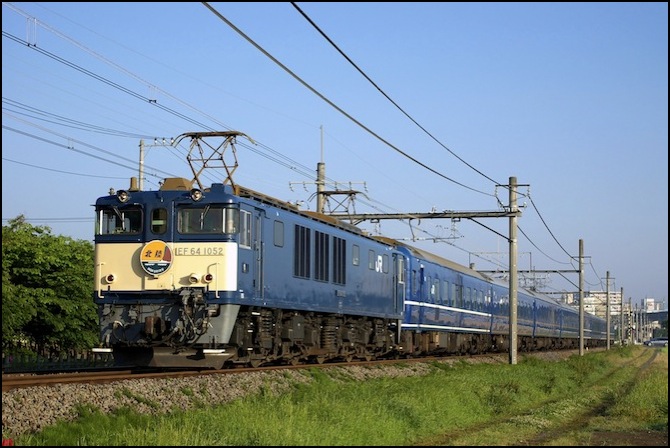
Hokuriku with EF64-1052 (2007)
Photographer: Sui-setz
References
JR East Routes & Maps page for Cassiopeia and Hokutosei (English)




